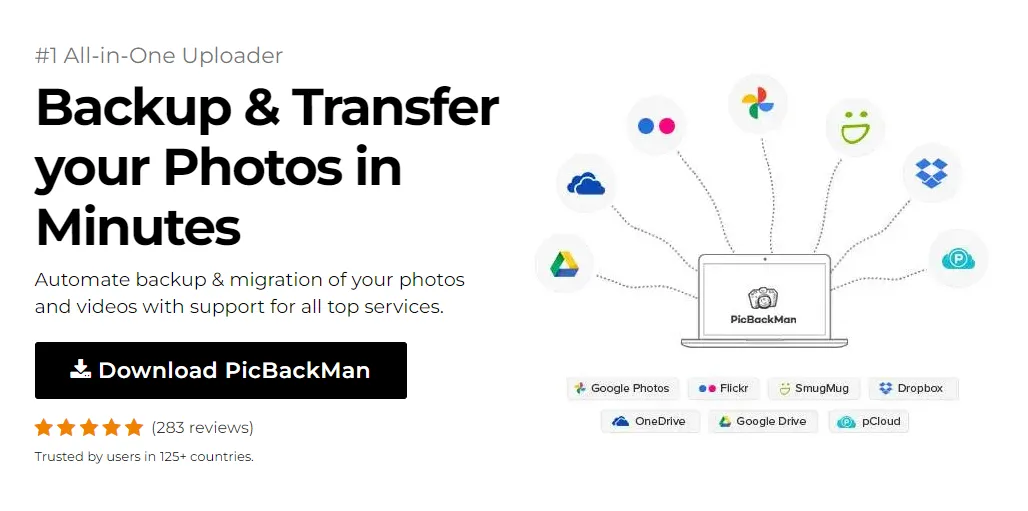‘Failed upload’ now what?
Backup & Transfer your Photos in Minutes
Automate backup & migration of your photos & videos with support for all top services.
Trusted by users in 125+ countries.
In our digital age, file uploads have become an integral part of our daily lives. Whether you're sharing photos on social media, submitting work assignments, or backing up important documents, the process of uploading files is crucial. However, encountering a failed upload can be frustrating and time-consuming. This comprehensive guide will explore the common causes of failed uploads, provide troubleshooting steps, and offer alternative solutions to ensure your files reach their intended destination.
'Failed Upload' Now What?
When faced with a failed upload, it's essential to remain calm and approach the situation systematically. The first step is to identify the potential cause of the failure. Common reasons for failed uploads include:
- Poor internet connection
- File size restrictions
- Server issues
- Incompatible file formats
- Browser or application problems
Once you've identified the possible cause, you can take appropriate action to resolve the issue. Let's dive deeper into each of these potential problems and their solutions.
Troubleshooting Poor Internet Connection
A stable internet connection is crucial for successful file uploads. If you suspect that your connection might be the culprit, try these steps:
-
Check your internet speed: Use online speed test tools like Speedtest.net or Fast.com to verify your connection's stability and speed.
-
Restart your router: Unplug your router for about 30 seconds, then plug it back in. This can often resolve connectivity issues.
-
Switch to a wired connection: If possible, connect your device directly to the router using an Ethernet cable for a more stable connection.
-
Try a different network: If available, switch to a different Wi-Fi network or use your mobile data to test if the problem persists.
-
Contact your ISP: If the issue continues, reach out to your Internet Service Provider for assistance.
By addressing connectivity problems, you can significantly improve your chances of a successful upload.
Dealing with File Size Restrictions
Many platforms and services have limitations on the size of files that can be uploaded. If you're encountering a failed upload due to file size restrictions, consider these solutions:
-
Check the platform's limits: Research the maximum file size allowed by the service you're using.
-
Compress the file: Use compression tools like 7-Zip or WinZip to reduce the file size without significant quality loss.
-
Split large files: For exceptionally large files, consider splitting them into smaller parts using file splitters like GSplit or HJSplit.
-
Use file compression websites: Online services like TinyPNG or CompressJPEG can help reduce image file sizes quickly.
-
Upgrade your account: Some platforms offer increased file size limits for premium users. Consider upgrading if you frequently work with large files.
By adapting your files to meet size requirements, you can overcome this common obstacle to successful uploads.
Addressing Server Issues
Sometimes, the problem lies not with your connection or files, but with the server you're uploading to. Here's how to tackle server-related issues:
-
Check the platform's status: Many services have status pages or Twitter accounts where they report known issues. Check these for any ongoing problems.
-
Try again later: If the server is experiencing high traffic or maintenance, waiting and trying again later may resolve the issue.
-
Clear your browser cache: Sometimes, cached data can interfere with uploads. Clear your browser's cache and cookies, then attempt the upload again.
-
Use a different browser: If the problem persists, try using a different web browser to rule out browser-specific issues.
-
Contact support: If you've exhausted other options, reach out to the platform's support team for assistance.
By being patient and persistent, you can often overcome server-related upload failures.
Handling Incompatible File Formats
File format incompatibility can lead to failed uploads. Here's how to address this issue:
-
Check accepted formats: Review the platform's guidelines for accepted file types.
-
Convert the file: Use file conversion tools like CloudConvert or Zamzar to change your file to a compatible format.
-
Update software: Ensure your applications and operating system are up-to-date to support the latest file formats.
-
Use universal formats: When possible, save files in widely accepted formats like PDF for documents or JPG for images.
-
Check for corruption: Use file checking tools to ensure your file isn't corrupted, which can cause upload failures.
By ensuring your files are in the correct format, you can eliminate a common cause of upload failures.
Resolving Browser and Application Issues
Sometimes, the problem lies with the software you're using to upload files. Here's how to troubleshoot these issues:
-
Update your browser: Ensure you're using the latest version of your web browser.
-
Disable extensions: Temporarily disable browser extensions, as they can sometimes interfere with uploads.
-
Try incognito mode: Use your browser's private or incognito mode to rule out issues with cached data or extensions.
-
Update the application: If you're using a specific application for uploads, make sure it's up-to-date.
-
Reinstall the software: As a last resort, uninstall and reinstall the browser or application you're using for uploads.
By addressing software-related issues, you can often resolve persistent upload problems.
Alternative Upload Methods
When traditional upload methods fail, consider these alternatives:
-
Cloud storage services: Use platforms like Google Drive, Dropbox, or OneDrive to upload files, then share links.
-
File transfer services: Websites like WeTransfer or Filemail allow you to send large files without registration.
-
FTP clients: For more technical users, File Transfer Protocol (FTP) clients can provide a reliable upload method.
-
Mobile apps: Many services offer mobile apps that can sometimes provide more stable upload experiences than web interfaces.
-
Physical media: For extremely large files or unreliable internet connections, consider using USB drives or external hard drives to transfer data physically.
By exploring these alternatives, you can often find a workaround for persistent upload issues.
Best Practices for Successful Uploads
To minimize the chances of encountering failed uploads in the future, consider adopting these best practices:
-
Prepare files in advance: Compress and format your files before attempting to upload them.
-
Use a reliable internet connection: Whenever possible, use a stable, high-speed internet connection for uploads.
-
Schedule large uploads: For significant file transfers, schedule them during off-peak hours when server traffic is likely to be lower.
-
Keep software updated: Regularly update your operating system, browsers, and applications to ensure compatibility and security.
-
Backup important files: Always keep backups of critical files in case of upload failures or data loss.
By incorporating these practices into your routine, you can significantly reduce the frequency of upload failures.
Quick Tip to ensure your videos never go missing
Videos are precious memories and all of us never want to ever lose them to
hard disk crashes or missing drives. PicBackMan is the easiest and simplest
way to keep your videos safely backed up in one or more online accounts.
Simply Download PicBackMan (it’s
free!), register your account, connect to your online store and
tell PicBackMan where your videos are – PicBackMan does the rest,
automatically. It bulk uploads all videos and keeps looking for new ones and
uploads those too. You don’t have to ever touch it.
FAQs
How do I transfer photos directly to my iPad?
To transfer photos directly to your iPad, you can use various methods:
- iCloud Photos: Enable this feature to automatically sync photos across your Apple devices.
- AirDrop: Use this to wirelessly transfer photos from another Apple device.
- USB cable: Connect your iPad to a computer and use iTunes or Finder to transfer photos.
- Third-party apps: Apps like Google Photos or Dropbox can be used to upload and sync photos to your iPad.
How do I transfer photos from iPad to computer without iTunes?
You can transfer photos from iPad to computer without iTunes using these methods:
- iCloud Photos: Access your photos on the computer through iCloud.com or the iCloud app.
- Email: Send photos to yourself via email and download them on your computer.
- Third-party apps: Use cloud storage apps like Google Drive or Dropbox.
- Windows Photos app: On Windows 10, you can import photos directly using the Photos app.
- Image Capture: On Mac, use the Image Capture app to import photos from your iPad.
How do I share photos between iPad and laptop?
Sharing photos between iPad and laptop can be done through various methods:
- Cloud services: Use iCloud, Google Photos, or Dropbox to sync photos across devices.
- AirDrop: If you have a Mac, use AirDrop for wireless transfer.
- USB cable: Connect your iPad to the laptop and use File Explorer (Windows) or Finder (Mac) to access photos.
- Email or messaging apps: Send photos via email or messaging apps like WhatsApp Web.
- Shared albums: Create shared albums in the Photos app to access photos on both devices.
How to transfer files from iPad to PC using USB?
To transfer files from iPad to PC using USB:
- Connect your iPad to the PC using a USB cable.
- Unlock your iPad and trust the computer if prompted.
- On your PC, open File Explorer.
- Look for your iPad under "This PC" or "Computer."
- Open the iPad folder to access its files.
- Copy the desired files from your iPad to your PC.
Note: For some file types, you may need to install iTunes or use specific apps that allow file sharing.
What is the best way to transfer files from PC to iPad?
The best way to transfer files from PC to iPad depends on your specific needs, but here are some effective methods:
- iCloud Drive: Upload files to iCloud Drive on your PC and access them on your iPad.
- iTunes File Sharing: Use iTunes to transfer files to specific apps on your iPad.
- Cloud storage services: Use Dropbox, Google Drive, or OneDrive to sync files between devices.
- Email: Send files as email attachments to yourself.
- AirDrop: If you have a Mac, use AirDrop for quick wireless transfers.
- Third-party file transfer apps: Apps like Documents by Readdle or File Explorer can facilitate file transfers.
How do I drop files from PC to iPad?
To drop files from PC to iPad:
-
Use cloud storage: Drag and drop files into a cloud storage folder (like iCloud Drive, Dropbox, or Google Drive) on your PC. Then access these files on your iPad through the respective app.
-
AirDrop (Mac only): Enable AirDrop on both devices, then drag and drop files onto your iPad's icon in the AirDrop window.
-
iTunes File Sharing: Connect your iPad to your PC, open iTunes, select your device, go to File Sharing, choose an app, and drag files into the documents list.
-
Email: Drag files into an email, send it to yourself, and open the attachments on your iPad.
-
Third-party apps: Use apps like Send Anywhere or Pushbullet that allow you to "push" files from PC to iPad.
Conclusion
Encountering a failed upload can be frustrating, but with the right approach, it's often a solvable problem. By systematically troubleshooting the issue, exploring alternative methods, and adopting best practices, you can overcome most upload challenges. Remember to stay patient, keep your software up-to-date, and always have a backup plan. With these strategies in your toolkit, you'll be well-equipped to handle any upload situation that comes your way.
Now, let's address some frequently asked questions related to file transfers and uploads:










